Sofia
![]()
The title of this article is ambiguous. For other meanings, see Sofia (disambiguation).
Sofia (German [ˈzoːfi̯a]; Bulgarian София, [ˈsɔfijɐ]) is the capital of Bulgaria. The city is located in the eponymous plain in the west of the country. With its 1,238,438 inhabitants (as of 2017), it is the largest and most populous city and administrative centre of the Sofia City District (oblast). This means that about one in six (17.5 percent) of Bulgaria's population lives in Sofia. Sofia is divided into 24 districts. The Iskar River and several smaller watercourses are located in the city area.
The city has been continuously inhabited since the Neolithic Age, making it one of the oldest settlements and cities in Europe. Known in ancient times as Serdica or Sardica and in the Middle Ages as Sredez, Sofia was elected the capital after Bulgaria regained its independence in 1878 and subsequently became the political, economic and cultural centre of the country. For this reason, the most important theatres, museums and other cultural institutions of the country are located here today.
With its universities, the oldest dating back to 1888, colleges and research institutes, Sofia is the country's preeminent educational center, and with numerous publishing houses, radio and television stations, and daily and monthly newspapers, it is also the country's dominant media center. Sofia is the seat of the Bulgarian government, the Bulgarian president, the Bulgarian Orthodox Church and other important administrative and military authorities, as well as the residence of the Bulgarian Patriarch.

Aerial view of the city centre
Geography
Location
Sofia is located in the Sofia Plain, a vast plateau in the west of the country, close to the border with Serbia. Five mountain passes lead to the plain and thus to Sofia - the Iskar Pass, the Vladaya Pass, the Dragoman Pass, the Petrokhan Pass and the Botevgrad Pass.
The city is located on the northern slope of the 2290 m high Vitosha Mountain, which is a popular destination for Sofia tourists and dominates the scenery of the whole city. The basic shape of the Vitosha Mountain is almost circular with a diameter of about 15 km. To the west, the city borders on the Lyulin and Losen Mountains.
To the north and northeast, at a distance of about 50 kilometres, run the Sofia Mountains and the Murgash Mountains, which are part of the Balkan Mountains that run east-west through the whole of Bulgaria, dividing the country into northern and southern halves. This mountain range is the namesake for the entire Balkan Peninsula.
The longest river in Bulgaria, the Iskar, flows through the eastern districts of the city. Two of its tributaries, the Perlowska and Wladajska also cross the city, but are hardly visible in the cityscape.
In the centre of Sofia, as in the districts of Ovcha Kupel, Knyazhevo, Gorna Banya and Pancharevo, there are mineral springs, the use of which has been proven since ancient times.
Climate
Sofia has a temperate continental climate. Due to the high altitude (550 m), winters are snowy and cold and summers are warm. The average annual temperature is 9.7 degrees Celsius, the average annual precipitation reaches 572 mm.
The warmest months are July and August with an average of 19.4 to 20.0 degrees Celsius and the driest are January and February with an average of 27 to 33 millimeters of precipitation. The greatest amount of precipitation is in May and June with an average of 73 to 75 millimeters. The coldest month is January with -1.6 degrees Celsius on average.
The Bulgarian capital is the foggiest city in the country, with about 33 days per year. A record for Bulgaria is 29 consecutive days of fog recorded in Sofia in December 1948.
| Sofia | ||||||||||||||||||||||||||||||||||||||||||||||||
| Climate diagram | ||||||||||||||||||||||||||||||||||||||||||||||||
| ||||||||||||||||||||||||||||||||||||||||||||||||
| Monthly average temperatures and precipitation for Sofia
Source: WMO: World Weather Information Service; humidity, sunshine hours: wetterkontor.de | |||||||||||||||||||||||||||||||||||||||||||||||||||||||||||||||||||||||||||||||||||||||||||||||||||||||||||||||||||||||||||||||||||||||||||||||||||||||||||||||||||||||||||||||||||||||||||||||||||||||||||||||||||||||||||||||||||||||||||||||||||||||||||||||||||||||||||
Administrative structure
→ Main article: Administrative division of Sofia
The city of Sofia is the center of the provinces of Sofia and Sofia City, as well as the Greater Sofia Municipality. The Great Municipality of Sofia geographically consists of the city of Sofia and three other towns and 34 villages.
Fifteen of the 24 rajons (Bulg. райони/rajoni) in the Sofia Grand Municipality include only parts of the city, 6 also include surrounding localities. Three of the municipality's rajons (Pancharevo, Novi Iskar and Bankya) include only areas outside the city limits, even though they are within Sofia City Province and fall under the jurisdiction of the Sofia Grand Municipality. Each of the rajons is divided into several districts and has a mayor elected by secret and direct ballot for a four-year term.
The boroughs are:
| 1. banya (Банкя) | 13. mladost (Младост) |

Sofia Municipalities
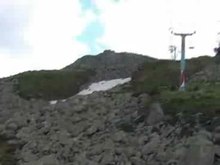
Play media file The "local mountain" of Sofia: The Vitosha Mountains (video)
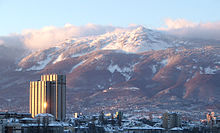
Sofia with Vitosha Mountains in the background
Population
Population development
Ottoman tax registers (Defter) give quite precise information about the population development. Thus in 1523/4 about 6,000, in 1544/5 about 8,000 and at the end of the 16th century over 9,000 inhabitants lived in the city. Christian travellers around 1640 already estimated the number of inhabitants at 71,600, 15,000 of whom were Jews. This population remained constant throughout the 18th century, according to Occidental travelers. The Salnames of 1872/3 record a population of about 35,000.
In 1878, the year of Bulgaria's liberation, the population was 11,694, to grow again to about 20,000 by 1887. In 1910, the capital's population reached 100,000, making it a major city. In 1946, half a million people already lived in the city, and by 1975 this number had doubled to one million.
In the period from 1990 to 2001, the population declined, but has also stabilized due to numerous incorporations. In 1999, 45 percent of the rural population around Sofia depended on home-produced food. The movement from the countryside to the capital was therefore reversed. The continuing economic crisis forced a new subsistence economy, often with the simplest implements such as a sickle and plough, as only a few village communities had enough money to collectively purchase a tractor.
Below are the population figures according to the respective territorial status. Up to 2001 and for 2011, these are census results, and 2006 is an estimate by the National Statistics Institute (NSI).
Diagram: Ethnic compositionAccording to the 2001 census, 96.0 per cent of the population are ethnic Bulgarians; 1.5 per cent are Roma and 0.5 per cent are Turks (→ Balkan Turks). In addition, Armenians, Serbs, Greeks, Wallachians and the Muslim, Bulgarian-speaking Pomaks live in Sofia. In general, minorities participate actively in the social and political life of the capital. They find a political voice in minority parties. ReligionsIn the last census in 2001, the vast majority of the population (96.4 percent) described themselves as Christians, and most belong to the Bulgarian Orthodox Church (95.9 percent). Religious minorities in Sofia include Muslims and a rapidly dwindling Jewish religious community of a few hundred people. These are mainly Sephardic Jews. For the Catholics, the modern St. Joseph's Cathedral, concathedral of the Roman Catholic diocese of Sofia and Plovdiv, was built in 2002-2006 in place of the neo-baroque church of 1875, which was destroyed in 1944. However, religiosity and trust in the church are much lower than in neighboring countries, which is often explained by the Bulgarian church's adaptation to the former communist regime. According to the European Values Study, only 52 percent of the population described themselves as religious in 1999, and only 22 percent go to church at least once a month.
|

Russian Church Sveti Nikolaj
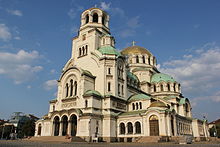
Alexander Nevsky Cathedral is the central Orthodox church of Sofia
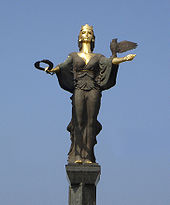
Statue of Sofia
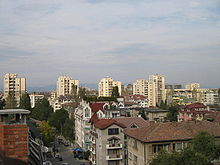
Residential
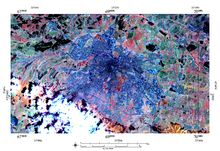
Extent of Sofia, NASA Landsat false color scene
Search within the encyclopedia